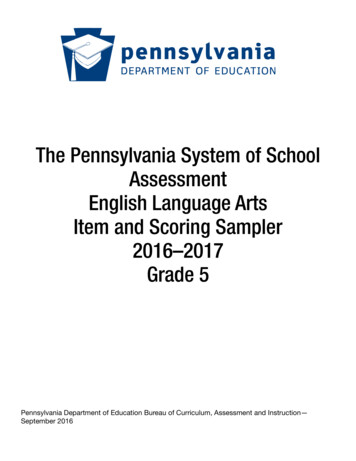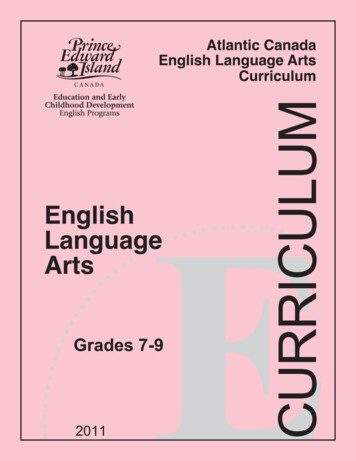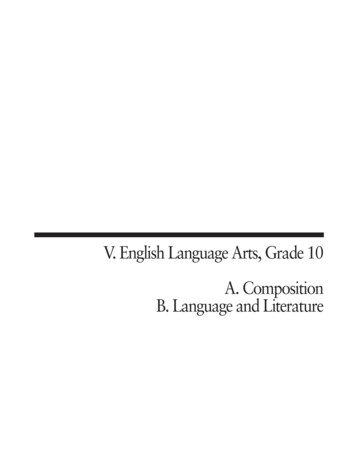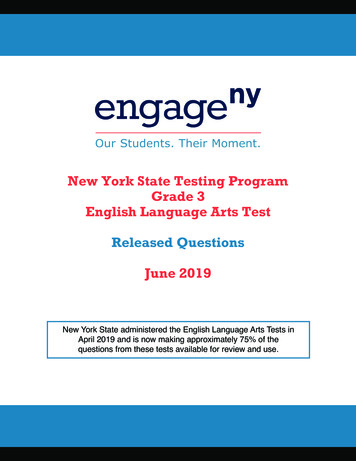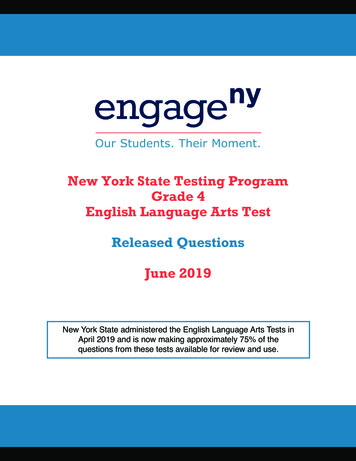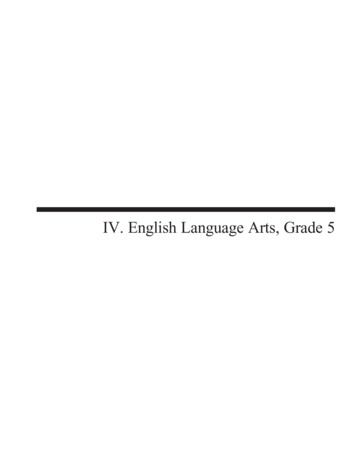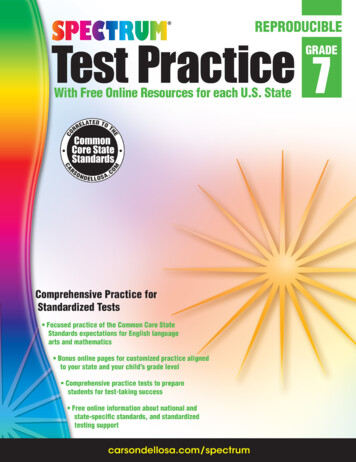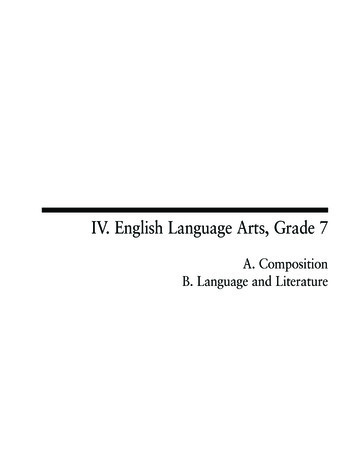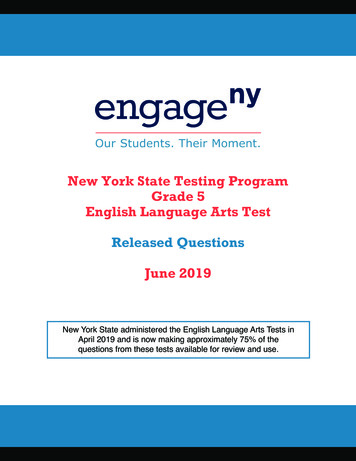
Transcription
New York State Testing ProgramGrade 5English Language Arts TestReleased QuestionsJune 2019New York State administered the English Language Arts Tests inApril 2019 and is now making approximately 75% of thequestions from these tests available for review and use.
THE STATE EDUCATION DEPARTMENT / THE UNIVERSITY OF THE STATE OF NEW YORK / ALBANY, NY 12234New York State Testing ProgramGrades 3–8 English Language ArtsReleased Questions from 2019 ExamsBackgroundIn 2013, New York State began administering tests designed to assess student performance in accordancewith the instructional shifts and rigor demanded by the new New York State P-12 Learning Standards inEnglish Language Arts (ELA). To help in this transition to new assessments, the New York State EducationDepartment (SED) has been releasing an increasing number of test questions from the tests that wereadministered to students across the State in the spring. This year, SED is again releasing large portions ofthe 2019 NYS Grades 3–8 English Language Arts and Mathematics test materials for review, discussion, anduse.For 2019, included in these released materials are at least 75 percent of the test questions that appearedon the 2019 tests (including all constructed-response questions) that counted toward students’ scores.Additionally, SED is providing information about the released passages; the associated text complexity foreach passage; and a map that details what learning standards each released question measures and thecorrect response to each question. These released materials will help students, families, educators, and thepublic better understand the tests and the New York State Education Department’s expectations forstudents.Understanding ELA QuestionsMultiple-Choice QuestionsMultiple-choice questions are designed to assess the New York State P-12 Learning Standards in EnglishLanguage Arts. These questions ask students to analyze different aspects of a given text, including centralidea, style elements, character and plot development, and vocabulary. Almost all questions, includingvocabulary questions, will be answered correctly only if the student comprehends and makes use of thewhole passage.For multiple-choice questions, students select the correct response from four answer choices. Multiplechoice questions assess reading standards in a variety of ways. Some ask students to analyze aspects of textor vocabulary. Many questions require students to combine skills. For example, questions may ask studentsto identify a segment of text that best supports the central idea. To answer these questions correctly, astudent must first comprehend the central idea and then show understanding of how that idea is supported.Questions tend to require more than rote recall or identification.Short-Response QuestionsShort-response questions are designed to assess New York State P-12 Reading and Language Standards.These are single questions in which a student uses textual evidence to support his or her answer to aninferential question. These questions ask the student to make an inference (a claim, position, or conclusion)
based on his or her analysis of the passage, and then provide two pieces of text-based evidence to supporthis or her answer.The purpose of the short-response questions is to assess a student’s ability to comprehend and analyzetext. In responding to these questions, students are expected to write in complete sentences. Responsesrequire no more than three complete sentences. The rubric used for evaluating short-response questionscan be found in the grade-level Educator Guides at sh-language-arts-and-mathematics.Extended-Response QuestionsExtended-response questions are designed to measure a student’s ability to write from sources. Questionsthat measure Writing from Sources prompt students to communicate a clear and coherent analysis of oneor two texts. The comprehension and analysis required by each extended response is directly related tograde-specific reading standards. Student responses are evaluated on the degree to which they meet gradelevel writing and language expectations. This evaluation is made by using a rubric that incorporates thedemands of grade-specific New York State P-12 Reading and Language standards.The integrated nature of the standards for ELA and literacy requires that students are evaluated across thestrands (Reading, Writing, and Language) with longer pieces of writing, such as those prompted by theextended-response questions. The rubric used for evaluating extended-response questions can be found inthe grade-level Educator Guides at ish-languagearts-and-mathematics.New York State P-12 Learning Standards AlignmentThe alignment(s) to the New York State P-12 Learning Standards for English Language Arts is/are intendedto identify the analytic skills necessary to successfully answer each question. However, some questionsmeasure proficiencies described in multiple standards, including writing and additional reading andlanguage standards. For example, two-point and four-point constructed-response questions requirestudents to first conduct the analyses described in the mapped standard and then produce writtenresponses that are rated based on writing standards. To gain greater insight into the measurement focusfor constructed-response questions, please refer to the rubrics.These Released Questions Do Not Comprise a “Mini Test”To ensure future valid and reliable tests, some content must remain secure for possible use on futureexams. As such, this document is not intended to be representative of the entire test, to show howoperational tests look, or to provide information about how teachers should administer the test; rather, itspurpose is to provide an overview of how the test reflects the demands of the New York State P-12 LearningStandards.The released questions do not represent the full spectrum of the standards assessed on the State tests, nordo they represent the full spectrum of how the standards should be taught and assessed in the classroom.It should not be assumed that a particular standard will be measured by an identical question in futureassessments. Specific criteria for writing test questions, as well as additional assessment information, areavailable at http://www.engageny.org/common-core-assessments.
2019 Grade 5 ELA Test Text Complexity Metrics forReleased Questions Available on EngageNYSelecting high-quality, grade-appropriate passages requires both objective textcomplexity metrics and expert judgment. For the Grades 3–8 assessments based on theNew York State P-12 Learning Standards for English Language Arts, both quantitativeand qualitative rubrics are used to determine the complexity of the texts and theirappropriate placement within a grade-level ELA exam.Quantitative measures of text complexity are used to measure aspects of textcomplexity that are difficult for a human reader to evaluate when examining a text.These aspects include word frequency, word length, sentence length, and text cohesion.These aspects are efficiently measured by computer programs. While quantitative textcomplexity metrics are a helpful start, they are not definitive.Qualitative measures are a crucial complement to quantitative measures. Usingqualitative measures of text complexity involves making an informed decision about thedifficulty of a text in terms of one or more factors discernible to a human readerapplying trained judgment to the task. To qualitatively determine the complexity of atext, educators use a rubric composed of five factors; four of these factors are requiredand one factor is optional. The required criteria are: meaning, text structure, languagefeatures, and knowledge demands. The optional factor, graphics, is used only if agraphic appears in the text.To make the final determination as to whether a text is at grade-level and thusappropriate to be included on a Grades 3–8 assessment, New York State uses a two-stepreview process, which is an industry best-practice. First, all prospective passagesundergo quantitative text complexity analysis using three text complexity measures. Ifat least two of the three measures suggest that the passage is grade-appropriate, thepassage then moves to the second step, which is the qualitative review using the textcomplexity rubrics. Only passages that are determined appropriate by at least two ofthree quantitative measures of complexity and are determined appropriate by thequalitative measure of complexity are deemed appropriate for use on the exam.For more information about text selection, complexity, and the review process pleaserefer lexity-grades-9-12
Degrees ofReading Power*Flesch-KincaidExcerpt from Snowflake BentleyExcerpt from Gregor and the SheepExcerpt from Seeds of Change: Planting aPath to PeaceExcerpt from Wackiest White House PetsExcerpt from BloomabilityExcerpt from Secrets of the Cicada SummerWordCount736816LexilePassage TitleReading MaturityMetric*Text Complexity Metrics for 2019 Grade 5 opriate* Depending on when the passage was selected, either the Reading Maturity Metric or Degrees of Reading Power wasused as the third quantitative metric.New York State 2019 Quantitative Text Complexity Chart for Assessment and CurriculumTo determine if a text’s quantitative complexity is at the appropriate grade level, NewYork State uses the table below. In cases where a text is excerpted from a large work,only the complexity of the excerpt that students see on the test is measured, not thelarge work, so it is possible that the complexity of a book might be above or below gradelevel, but the text used on the assessment is at grade level. Because the measurementof text complexity is inexact, quantitative measures of complexity are defined by gradeband rather than by individual grade level and then paired with the qualitative review byan �10th11th–12thATOS2.75 – 5.144.97 – 7.037.00 – 9.989.67 – 12.0111.20 – 14.10Degrees ofReadingPower42 – 5452 – 6057 – 6762 – 7267 – 74Source: Student Achievement PartnersFlesch-Kincaid1.98 – 5.344.51 – 7.736.51 – 10.348.32 – 12.1210.34 – 14.20The LexileFramework420 – 820740 – 1010925 – 11851050 – 13351185 – 1385ReadingMaturity3.53 – 6.135.42 – 7.927.04 – 9.578.41 – 10.819.57 – 12.00SourceRater0.05 – 2.480.84 – 5.754.11 – 10.669.02 – 13.9312.30 – 14.50
RELEASED QUESTIONS
Excerpt from Snowflake Bentley by Jacqueline Briggs Martin. Copyright 1998 by Jacqueline Briggs Martin. Used with permission ofHoughton Mifflin Harcourt Company via Copyright Clearance Center.Excerpt from “Gregor and the Sheep” by Toby Rosenstrauch. Copyright 2007 by Toby Joan Rosenstrauch. Used with permission.Excerpt from Seeds of Change: Planting a Path to Peace by Jen Cullerton Johnson. Copyright 2010 by Lee & Low Books. Used withpermission.Developed and published under contract with the New York State Education Department by Questar Assessment Inc., 5550 Upper 147thStreet West, Minneapolis, MN 55124. Copyright 2019 by the New York State Education Department.Session 1
Session 1TIPS FOR TAKING THE TESTHere are some suggestions to help you do your best: Be sure to read all the directions carefully. ost questions will make sense only when you read the whole passage. You may readMthe passage more than once to answer a question. When a question includes a quotationfrom a passage, be sure to keep in mind what you learned from reading the wholepassage. You may need to review both the quotation and the passage in order to answerthe question correctly. Read each question carefully and think about the answer before making your choice.Session 1Page 1
Read this article. Then answer questions 8 through 14.Excerpt from Snowflake Bentleyby Jacqueline Briggs Martin1In the days when farmers worked with ox and sled and cut the dark with lanternlight, there lived a boy who loved snow more than anything in the world. WillieBentley’s happiest days were snowstorm days. He watched snowflakes on his mittens,on the dried grass of Vermont farm fields, on the dark metal handle of the barn door.He said snow was as beautiful as butterflies, or apple blossoms.2He could net butterflies and show them to his older brother, Charlie. He could pickapple blossoms and take them to his mother. But he could not share snowflakes becausehe could not save them.3When his mother gave him an old microscope, he used it to look at flowers,raindrops, and blades of grass. Best of all, he used it to look at snow. While otherchildren built forts and pelted snowballs at roosting crows, Willie was catchingsnowflakes. Day a er stormy day he studied the icy crystals.4 eir intricate patterns were even more beautiful than he had imagined. Heexpected to find whole flakes that were the same, that were copies of each other. But henever did. Willie decided he must find a way to save snowflakes so others could seetheir wonderful designs. For three winters he tried drawing snow crystals. ey alwaysmelted before he could finish.5When he was sixteen, Willie read of a camera with its own microscope. “If I had thatcamera I could photograph snowflakes,” he told his mother. Willie’s mother knew thathe would not be happy until he could share what he had seen.6“Fussing with snow is just foolishness,” his father said. Still, he loved his son. WhenWillie was seventeen his parents spent their savings and bought the camera. It wastaller than a newborn calf, and cost as much as his father’s herd of ten cows. Willie wassure it was the best of all cameras.7Even so his first pictures were failures—no better than shadows. Yet he would notquit. Mistake by mistake, snowflake by snowflake, Willie worked through every storm.Winter ended, the snow melted, and he had no good pictures. He waited for anotherGO ONSession 1Page 7
season of snow. One day, in the second winter, he tried a new experiment. And itworked! Willie had figured out how to photograph snowflakes! “Now everyone can seethe great beauty in a tiny crystal,” he said.8But in those days, no one cared. Neighbors laughed at the idea of photographingsnow. “Snow in Vermont is as common as dirt,” they said. “We don’t need pictures.”Willie said the photographs would be his gi to the world. While other farmers sat bythe fire or rode to town with horse and sleigh, Willie studied snowstorms. He stood atthe shed door and held out a black tray to catch the flakes.9When he found only jumbled, broken crystals, he brushed the tray clean with aturkey feather and held it out again. He waited hours for just the right crystal anddidn’t notice the cold. If the shed were warm the snow would melt. If he breathed onthe black tray the snow would melt. If he twitched a muscle as he held the snow crystalon the long wood pick the snowflake would break. He had to work fast or the snowflakewould evaporate before he could slide it into place and take its picture. Some winters hewas able to make only a few dozen good pictures. Some winters he made hundreds. . . .10But his snow crystal pictures were always his favorites. He gave copies away or soldthem for a few cents. He made special pictures as gi s for birthdays. He held eveningslide shows on the lawns of his friends. Children and adults sat on the grass andwatched while Willie projected his slides onto a sheet hung over a clothesline.11He wrote about snow and published his pictures in magazines. He gave speechesabout snow to faraway scholars and neighborhood skywatchers. “You are doing greatwork,” said a professor from Wisconsin. e little farmer came to be known as theworld’s expert on snow, “the Snowflake Man.” But he never grew rich. He spent everypenny on his pictures. Willie said there were treasures in snow. “I can’t afford to miss asingle snowstorm,” he told a friend. “I never know when I will find some wonderfulprize.”GO ONPage 8Session 1
8Read this sentence from paragraph 1 of the article.In the days when farmers worked with ox and sled and cut the dark with lantern light,there lived a boy who loved snow more than anything in the world.How does the author’s word choice in the sentence affect the meaning of the passage?9Aby suggesting that the ideas in the passage are made upBby showing that the subject of the passage became famousCby suggesting that the topic of the passage is familiarDby showing that the events in the passage happened long agoWhat is the meaning of the word “pelted” as it is used in paragraph 3?AcreatedBfoundCsavedDthrewGO ONSession 1Page 9
101112Which quotation best supports a main idea of the article?A“He expected to find whole flakes that were the same . . .” (paragraph 4)B“ ‘Fussing with snow is just foolishness,’ his father said.” (paragraph 6)C“Even so his first pictures were failures . . .” (paragraph 7)D“ ‘Now everyone can see the great beauty in a tiny crystal,’ he said.”(paragraph 7)What does the information in paragraph 9 suggest about the author’s point of view?A e author believes that Bentley could have been more careful.B e author respects Bentley’s many different interests.C e author admires Bentley’s dedication.D e author questions the methods Bentley used.Which statement is true based on the information in paragraphs 6 and 11?ABentley’s work with snow required expensive equipment that he was willingto spend all his money on.BBentley was thought to be foolish throughout his life because of his interestin snow.CBentley’s parents thought he should do something with his life other thantaking pictures of snow.DBentley became less interested in studying snow than in publishing picturesand giving speeches.GO ONPage 10Session 1
1314What does the reader learn about Bentley from paragraphs 10 and 11?AHe was more interested in sharing his work than in making money from it.BHe worked hard to develop a way of making photographs of snowflakes.CHe wanted to find out if all snowflakes were different from each other.DHe was able to follow his interests because of the help he got from hisfamily.Which sentence best describes how the article is organized?A e reasons for Willie Bentley’s experiments with snow are presented,followed by their eventual conclusions.B e events of Willie Bentley’s life and his study of snow are described asthey happened over time.C e different problems of photographing snow are explained and thenWillie Bentley’s solutions are described.D e important ideas about snow in Willie Bentley’s discoveries arepresented, followed by details and examples.GO ONSession 1Page 11
Read this story. Then answer questions 15 through 21.Excerpt from Gregor and the Sheepby Toby Rosenstrauch1In a valley in the highlands of Scotland, there once lived a young tenant farmer,Gregor, and his widowed mother. Although they worked hard, they could neveraccumulate enough money to buy the flock of sheep they longed to have, for their smallparcel of land produced only modest amounts of oats and barley. To make mattersworse, MacTavish, the owner of this and many other cro s, always found reasons not topay the farmers all they had earned. . . .crofts small farms2When he opened the door each morning and looked out, he saw MacTavish’s houseon top of a mountain, a magnificent stone mansion surrounded by red, pink, and violetrhododendrons. Gregor o en climbed the slope and stood outside the iron gates,wondering what fine furnishings and delicious foods lay within. Neighbors claimedthat MacTavish owned many houses and even kept a chest of gems under his bed. AsGregor, his mother, and their neighbors grew gaunt and pale with hard work and notenough food, they railed against MacTavish, who had swindled all of them at one timeor another.swindled cheated or tricked3One day, as Gregor listened to the bagpipe music that dri ed from the openwindows of MacTavish’s mansion, he had an idea. at night, when his mother wasasleep, he emptied the jug that held their money and counted it. A er putting back afew coins for food, he put the rest in his pocket. e next morning, he hurried to themarket, where he went from farmer to farmer, asking the prices of sheep for sale.Gregor found many handsome animals, but they were all too expensive. When hereached a stall with scrawny and sickly sheep, the owner beckoned to him. . . .4Gregor shook his head and began to walk away. e man grabbed his sleeve andwhispered in his ear, “ is one will make her owner rich!” Gregor examined the oldGO ONPage 12Session 1
sheep with spindly legs and dirty, unkempt wool—the worst of the lot. “If she will makeme rich,” said Gregor, “how is it that she has not done so for you?”5 e man paused, thinking. “I have not had her long enough!”6“Nonsense,” said Gregor, but he gave the man his money and led the pitiful animalhome.7When his mother saw what he had bought with their money, she burst into tears.“My foolish son, what have you done? Now we will starve, and no one will help us!”8“Do as I say, Mother, and we will be rich. I promise.”9She wanted to believe him. Wiping her eyes with her ragged sleeve, she asked whathe wanted her to do.10“Go to market and tell everyone that your son has a sheep that will make whoeverowns her rich,” said Gregor. . . .11One morning, a carriage arrived. Two servants opened the door and a stout, welldressed gentleman emerged. His Tartan kilt was made of the finest wool, his ascot waspure silk, and his shoes had silver buckles. On his fat fingers were eight gold rings, andhis pomaded hair glistened in the sun. It was MacTavish!Tartan kilt traditional clothing worn by Scottish Highlandersascot a type of necktie12Gregor bowed as if to royalty. MacTavish looked at him sternly. “I have come to ridyou of the unfortunate sheep that everyone is talking about,” said MacTavish, openinghis sporran. “I can pay your price and I will have her, even though she has donenothing for you, I see.” MacTavish sneered at Gregor.sporran a small bag worn at the waist for holding personal items13Gregor hugged Dear One. “I will not sell her to you!”14At that, MacTavish, whose servants were helping him into his carriage, turned andmarched back. “I will pay anything,” he said. “Name the price.”15Gregor was ready. “ at,” he said, pointing up to the mansion above them. “I willhave the dwelling and everything in it—furniture, utensils, even the chest of gemsunder your bed.”GO ONSession 1Page 13
16“Done,” said MacTavish.17 e next day, Gregor and his mother moved into the mansion that had oncebelonged to MacTavish, and MacTavish brought Dear One to the market so that allmight see he could indeed own anything he wanted. en MacTavish and the sheeprode away in his carriage to another of his houses in a valley beyond the mountains.18A er months had passed and the sheep had done nothing to increase MacTavish’sriches, he realized he had been swindled. Furious beyond speech, he returned to themansion, but Gregor would not open the gates.1920“I have been cheated!” shouted MacTavish.“You have not been cheated,” said Gregor. “I was the owner of the sheep, and she hasmade me rich, hasn’t she?”21“Yes, but . . . ,” sputtered MacTavish.22“ en you got what you paid for.” Gregor turned and walked away.23Soon a erward, Gregor sold the chest of gems and bought the huge flock of sheep heand his mother had always wanted. He shared the rest of his fortune with the otherpoor families of the valley who had been cheated by MacTavish.GO ONPage 14Session 1
151617How do paragraphs 1 and 23 relate to each other?A ey show the change in Gregor’s life during the story.B ey show what Gregor has learned in the story.C ey show how MacTavish changes in the story.D ey show the growth of MacTavish’s fortune during the story.What does the phrase “marched back” in paragraph 14 suggest about MacTavish?AHe is confused.BHe is worried.CHe is determined.DHe is excited.How are Gregor and the man who sold the sheep to him similar?A ey are both unskilled at selling things to people.B ey both try to trick someone in order to make money.C ey are both concerned with helping their family and neighbors.D ey both believe that animals can have special qualities.GO ONSession 1Page 15
181920Which of Gregor’s actions shows how he is different from MacTavish?AGregor cheats another person.BGregor buys a sickly sheep.CGregor shares his wealth.DGregor moves to a big house.Which sentence is true about Gregor and MacTavish?AMacTavish has a plan for how the sheep will make him rich, but Gregordoes not.BMacTavish wants to own big houses and many jewels, but Gregor does not.CGregor wants to move away to another land, but MacTavish does not.DGregor is generous with his family and his neighbors, but MacTavish is not.Which sentence expresses a theme of the story?ABig loss can come from being greedy.BFamily can make hard times seem easier.CWealth may come from hard work.DAppreciating others can lead to happiness.GO ONPage 16Session 1
21Which detail would be most important to include in a summary of the story?AGregor goes to the market and talks to many farmers about their sheep.BGregor’s mother is asleep when Gregor takes money to buy the sheep.CMacTavish lives at another one of his houses a er he buys the sheep fromGregor.DMacTavish goes to buy Gregor’s sheep a er he hears rumors about theanimal.GO ONSession 1Page 17
Read this article. Then answer questions 29 through 35. is is the true story of a Kenyan woman named Wangari Maathai.Excerpt from Seeds of Change:Planting a Path to Peaceby Jen Cullerton Johnson123“Come,” Wangari’s mother called. She beckoned her young daughter over to a talltree with a wide, smooth trunk and a crown of green, oval leaves.“Feel,” her mother whispered.Wangari spread her small hands over the tree’s trunk. She smoothed her fingers overthe rough bark.4“ is is the mugumo,” her mother said. “It is home to many. It feeds many too.”5She snapped off a wild fig from a low branch, and gave it to her daughter. Wangariate the delicious fruit, just as geckos and elephants did. High in the tree, birds chirpedin their nests. e branches bounced with jumping monkeys.6“Our people, the Kikuyu of Kenya, believe that our ancestors rest in the tree’sshade,” her mother explained.7Wangari wrapped her arms around the trunk as if hugging her great-grandmother’sspirit. She promised never to cut down the tree. . . .8When Wangari finished elementary school, she was eleven years old. Her mind waslike a seed rooted in rich soil, ready to grow. Wangari wanted to continue hereducation, but to do so she would have to leave her village and move to the capital cityof Nairobi. Wangari had never been farther than her valley’s ridge. She was scared.9“Go,” her mother said. She picked up a handful of earth and placed it gently into herdaughter’s hand. “Where you go, we go.” . . .10As graduation neared, Wangari told her friends she wanted to become a biologist.11“Not many native women become biologists,” they told her.12“I will,” she said.GO ONPage 24Session 1
13Wangari watched sadly as her government sold more and more land to bigcompanies that cut down forests for timber and to clear land for coffee plantations.Native trees such as cedar and acacia vanished. Without trees, birds had no place tonest. Monkeys lost their swings. Tired mothers walked miles for firewood. . . .14When Wangari visited her village she saw that the Kikuyu custom of not choppingdown the mugumo trees had been lost. No longer held in place by tree roots, the soilstreamed into the rivers. e water that had been used to grow maize, bananas, andsweet potatoes turned to mud and dried up. Many families went hungry.15Wangari could not bear to think of the land being destroyed. Now married and themother of three children, she worried about what would happen to the mothers andchildren who depended on the land.16“We must do something,” Wangari said.17Wangari had an idea as small as a seed but as tall as a tree that reaches for the sky.“Harabee! Let’s work together!” she said to her countrywomen—mothers like her.Wangari dug deep into the soil, a seedling by her side. “We must plant trees.” . . .18Wangari traveled to villages, towns, and cities with saplings and seeds, shovels andhoes. At each place she went, women planted rows of trees that looked like green beltsacross the land. Because of this they started calling themselves the Green BeltMovement.19“We might not change the big world but we can change the landscape of theforest,” she said.20One tree turned to ten, ten to one hundred, one hundred to one million, all the wayup to thirty million planted trees. Kenya grew green again. Birds nested in new trees.Monkeys swung on branches. Rivers filled with clean water. Wild figs grew heavy inmugumo branches.21Mothers fed their children maize, bananas, and sweet potatoes until they could eatno more.GO ONSession 1Page 25
2930What idea is developed in paragraphs 4 through 7?AWangari and her mother want to plant more trees.BMugumo trees are important to people and animals.CMugumo trees can provide shade to many people.DWangari and her mother think education is important.Read this sentence from paragraph 8 of the article.Her mind was like a seed rooted in rich soil, ready to grow.What does the sentence help the reader to understand about Wangari?31AShe likes to think about plants.BShe wants to keep learning.CShe imagines ways to help others.DShe believes in working together.How are the details in paragraphs 13 and 14 organized?Aas a description of how animal habitats changedBas an explanation of the solution to
band rather than by individual grade level and then paired with the qualitative review by an educator. Grade Band ATOS Degrees of Reading Power Flesch-Kincaid The Lexile Framework Reading Maturity SourceRater 2. nd – 3. rd. 2.75 – 5.14 42 – 54 1.98 – 5.34 420 – 82
